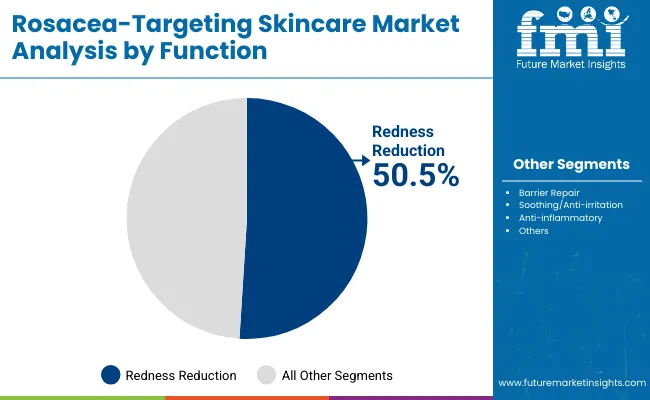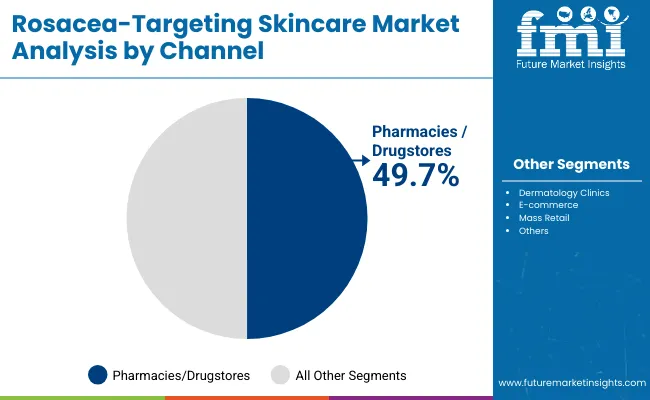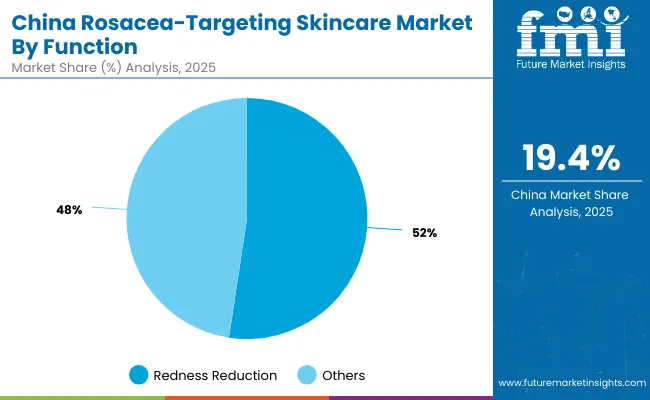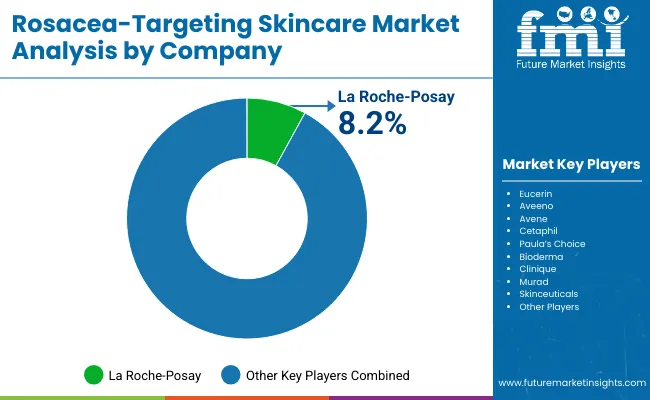The Rosacea-Targeting Skincare Market is expected to record a valuation of USD 3,203.5 million in 2025 and USD 7,601.8 million in 2035, with an increase of USD 4,398.3 million, which equals a growth of 137% over the decade. The overall expansion represents a CAGR of 9.0% and a near 2.4X increase in market size.

Rosacea-Targeting Skincare Market Key Takeaways
| Metric | Value |
|---|---|
| Rosacea-Targeting Skincare Market Estimated Value in (2025E) | USD 3,203.5 million |
| Rosacea-Targeting Skincare Market Forecast Value in (2035F) | USD 7,601.8 million |
| Forecast CAGR (2025 to 2035) | 9.0% |
During the first five-year period from 2025 to 2030, the market increases from USD 3,203.5 million to USD 4,934.8 million, adding USD 1,731.3 million, which accounts for 39% of the total decade growth. This phase records steady adoption in pharmacies/drugstores and dermatology clinics, driven by growing awareness of clinical skincare and demand for fragrance-free and sensitive-skin-safe claims. Fragrance-free products dominate this period with over 56% share, and redness reduction formulations lead by function with more than 50% share in 2025.
The second half from 2030 to 2035 contributes USD 2,667.0 million, equal to 61% of total growth, as the market jumps from USD 4,934.8 million to USD 7,601.8 million. This acceleration is powered by rapid expansion in e-commerce and premium dermocosmetic lines, supported by strong growth in China (CAGR 19.4%) and India (CAGR 21.4%). By 2035, digital-first direct-to-consumer brands and AI-personalized skincare platforms strengthen recurring revenue streams, while organic-certified and cold-pressed formulations capture a larger share in the premium segment.
From 2020 to 2024, the Rosacea-Targeting Skincare Market steadily expanded as awareness of rosacea-related skin concerns increased. Growth was driven by dermatology-led recommendations, consumer preference for sensitive-skin-safe products, and early adoption of fragrance-free creams and serums. During this period, the competitive landscape was dominated by established dermocosmetic brands such as La Roche-Posay and Eucerin, which together captured a significant share of prescription-backed and OTC formulations. Differentiation relied heavily on clinical validation, dermatologist endorsements, and pricing accessibility, while niche entrants focused on botanical and anti-inflammatory actives had limited traction. Service-based digital skincare platforms accounted for less than 10% of the total market value.
Demand for Rosacea-Targeting Skincare is projected to reach USD 3,203.5 million in 2025, and the revenue mix will shift toward premium dermocosmetic lines and digital-first retail channels. Traditional leaders face rising competition from direct-to-consumer (D2C) brands offering AI-personalized routines, subscription-based models, and refillable packaging. Emerging entrants specializing in organic-certified, cold-pressed oils, and clean-label formulations are gaining share. The competitive advantage is moving away from legacy dermatologist-backed dominance toward ecosystem strength, digital scalability, and sustainability-driven brand equity.
Growing awareness of rosacea as a chronic skin condition has significantly increased diagnosis rates and treatment-seeking behavior. Dermatologists are recommending specialized formulations such as fragrance-free creams, serums with niacinamide, and colloidal oatmeal-based products, driving consumer trust. Clinical validation and dermatologist-tested claims are becoming strong purchase drivers, especially in North America and Europe. This emphasis on science-backed efficacy ensures continuous consumer adoption and positions rosacea-targeting products as essential dermocosmetic solutions.
The market is being propelled by the rapid growth of e-commerce platforms, D2C skincare brands, and AI-powered personalized routine builders. Consumers increasingly prefer digital platforms that offer subscription-based, refillable, and customized skincare options tailored to sensitive skin needs. Meanwhile, premium dermocosmetic lines in Asia-Pacific particularly in China and India are growing at double-digit CAGRs, supported by clean-label, vegan, and organic-certified claims. This blend of digital convenience and premium positioning is fueling sustained market growth globally.
The Rosacea-Targeting Skincare Market is segmented by function, product type, active ingredient, claim, channel, and region. By function, the key categories are redness reduction, barrier repair, soothing/anti-irritation, and anti-inflammatory formulations. Product types include creams/lotions, serums, cleansers, and gels, catering to different consumer preferences and skin sensitivities. Active ingredient segmentation highlights niacinamide, azelaic acid, centellaasiatica, and colloidal oatmeal as leading actives.
Claims are dominated by fragrance-free, hypoallergenic, dermatologist-tested, and sensitive-skin-safe labels. Distribution channels comprise pharmacies/drugstores, dermatology clinics, e-commerce, and mass retail. Regionally, the market spans North America, Europe, Asia-Pacific, Latin America, and the Middle East & Africa, with China and India emerging as the fastest-growing markets.

| Claim | Value Share% 2025 |
|---|---|
| Fragrance-free | 56.6% |
| Others | 43.4% |
The fragrance-free segment is projected to contribute 56.6% of the Rosacea-Targeting Skincare Market revenue in 2025, maintaining its lead as the dominant claim category. This is driven by rising consumer awareness of skin sensitivities and the strong preference for formulations free from artificial fragrances that may trigger irritation or flare-ups. Adoption is further accelerated by dermatologist endorsements and clinical validation, positioning fragrance-free products as safer and more trustworthy.
The segment’s growth is also reinforced by its overlap with hypoallergenic and sensitive-skin-safe claims, making it a cornerstone of rosacea-focused skincare portfolios. As clean-label and vegan claims gain traction, fragrance-free remains the backbone of trust and compliance in the global rosacea skincare landscape.

| Function | Value Share% 2025 |
|---|---|
| Redness reduction | 50.5% |
| Others | 49.5% |
The redness reduction segment is forecasted to hold 50.5% of the market share in 2025, led by its strong application in addressing visible facial redness, a core concern for rosacea patients. These formulations are favored for their ability to calm inflamed skin, reduce flare-ups, and improve overall complexion, making them central to both prescription and over-the-counter products. Their widespread adoption in creams, serums, and cleansers reflects consumer demand for immediate soothing effects.
Growth is further supported by clinical validation and inclusion of active ingredients like azelaic acid and niacinamide, which enhance efficacy. As awareness of rosacea rises and consumers seek products with measurable improvements, redness reduction is expected to maintain its dominance in the global rosacea skincare landscape.

| Channel | Value Share% 2025 |
|---|---|
| Pharmacies/drugstores | 49.7% |
| Others | 50.3% |
The pharmacies/drugstores segment is projected to account for 49.7% of the Rosacea-Targeting Skincare Market revenue in 2025, establishing it as the leading distribution channel. This channel is preferred for its trusted environment, pharmacist guidance, and accessibility, which are critical for consumers managing a chronic condition like rosacea. Pharmacies provide a reliable platform for both over-the-counter dermocosmetic brands and dermatologist-recommended formulations.
Growth is further supported by the expansion of retail pharmacy chains, dedicated skincare sections, and hybrid pharmacy-e-commerce models that improve product availability. Given the balance of trust, accessibility, and professional validation, pharmacies/drugstores are expected to retain their leading role in the rosacea skincare market throughout the forecast period.
Rising Dermatological Recommendations
One of the strongest growth drivers is the rising number of dermatologists recommending specialized rosacea skincare solutions. Clinical evidence supporting active ingredients like azelaic acid, niacinamide, and colloidal oatmeal has reinforced trust among patients and consumers. Prescription-backed endorsements, combined with OTC availability, are creating a bridge between medical treatment and cosmetic skincare. As awareness campaigns and dermatology consultations become more frequent, consumers are turning to products with proven efficacy. This trend ensures that clinically validated, dermatologist-tested products remain at the forefront of rosacea management, fueling steady market expansion worldwide.
Expansion of E-commerce and D2C Channels
The increasing role of e-commerce and direct-to-consumer (D2C) channels is a major driver of growth. Online platforms not only improve accessibility but also allow brands to leverage personalized recommendations, subscription models, and refill programs tailored to rosacea patients. D2C brands integrate AI-powered tools to customize skincare routines, further strengthening consumer engagement. This channel expansion is particularly strong in Asia-Pacific, where digital-first shopping behavior is surging. By removing barriers related to limited shelf space in traditional retail, e-commerce ensures wider product availability and accelerates adoption, especially among tech-savvy and younger demographics.
High Cost of Premium Dermocosmetics
A key restraint in the market is the high price of premium dermocosmetic products formulated for rosacea management. Specialized formulations often use organic-certified, cold-pressed oils or encapsulated actives, which raise manufacturing costs. This results in a pricing gap that restricts accessibility in emerging economies and among cost-sensitive consumers. While pharmacies and clinics offer credibility, they often stock higher-priced options, leaving budget-conscious buyers reliant on generic products. Such affordability challenges hinder market penetration across lower-income segments, slowing adoption despite growing demand. Addressing this cost barrier remains critical for unlocking untapped growth potential.
Clean Label and Sustainability Integration
A notable trend shaping the market is the integration of clean-label and sustainability claims in rosacea-targeting skincare. Consumers increasingly seek products that are not only effective but also safe, vegan, fragrance-free, and environmentally responsible. Brands are incorporating upcycled rice bran oil, biodegradable packaging, and refill models to enhance eco-credibility. At the same time, certification standards like COSMOS and NATRUE are gaining influence, reinforcing trust in ingredient sourcing and product safety. This alignment of skincare efficacy with sustainability values resonates with health-conscious and eco-aware consumers, positioning clean and green solutions as a key differentiator in competitive markets.

| Countries | Estimated CAGR (2025 to 2035) |
|---|---|
| China | 19.4% |
| USA | 8.4% |
| India | 21.4% |
| UK | 11.8% |
| Germany | 9.7% |
| Japan | 15.5% |
The global Rosacea-Targeting Skincare Market demonstrates notable disparities in adoption speed, influenced by consumer awareness, dermatological practices, and retail accessibility. Asia-Pacific emerges as the fastest-growing region, led by India (21.4% CAGR) and China (19.4% CAGR). India’s growth reflects increasing dermatology consultations, rising awareness of chronic skin conditions, and rapid e-commerce penetration.
China benefits from expanding dermocosmetic portfolios, digital-first skincare platforms, and premium consumer spending on sensitive-skin-safe products. Europe maintains a strong profile, anchored by Germany (9.7%) and the UK (11.8%), supported by clinical endorsement, regulatory standards, and demand for fragrance-free formulations. Japan (15.5%) shows strong uptake due to biotech-driven actives and consumer interest in microbiome-friendly skincare.
Meanwhile, North America, led by the USA (8.4%), records moderate but steady growth, reflecting market maturity and reliance on trusted pharmacy chains and established dermocosmetic brands.

| Year | USA Rosacea-Targeting Skincare Market (USD Million) |
|---|---|
| 2025 | 645.35 |
| 2026 | 697.46 |
| 2027 | 753.77 |
| 2028 | 814.64 |
| 2029 | 880.42 |
| 2030 | 951.51 |
| 2031 | 1,028.33 |
| 2032 | 1,111.37 |
| 2033 | 1,201.11 |
| 2034 | 1,298.09 |
| 2035 | 1,402.90 |
The Rosacea-Targeting Skincare Market in the United States is projected to grow at a CAGR of 8.4% from 2025 to 2035, driven by rising consumer awareness, dermatological recommendations, and increased availability of dermocosmetic formulations. Pharmacies and drugstores remain the dominant distribution channel, but e-commerce growth is accelerating, particularly through D2C brands offering fragrance-free and dermatologist-tested products. Demand for redness-reduction formulations and barrier-repair creams is high, supported by consumers seeking long-term solutions for sensitive skin. Premiumization trends, AI-personalized skincare routines, and subscription-based models are further boosting recurring revenues.
The Rosacea-Targeting Skincare Market in the United Kingdom is expected to grow at a CAGR of 11.8% from 2025 to 2035, supported by rising demand for dermatologist-tested and fragrance-free formulations. Consumers are increasingly turning to barrier-repair creams and redness-reduction serums as awareness of rosacea as a chronic skin condition grows. Pharmacies and drugstores dominate distribution, but online platforms are gaining traction, offering access to international dermocosmetic brands and subscription-based sensitive skin product lines. Government-backed health campaigns on skin conditions, combined with strong collaboration between dermatology clinics and research institutions, continue to drive adoption.
India is witnessing rapid growth in the Rosacea-Targeting Skincare Market, which is forecast to expand at a CAGR of 21.4% through 2035, the fastest among all major countries. This expansion is fueled by rising awareness of rosacea-related skin conditions, increasing dermatology consultations, and the availability of affordable formulations in tier-2 and tier-3 cities. Pharmacies and e-commerce platforms are broadening access, while international brands are entering the market with tailored solutions for sensitive Indian skin. Educational campaigns and dermatology-led outreach are further improving diagnosis and treatment adoption.
The Rosacea-Targeting Skincare Market in China is expected to grow at a CAGR of 19.4% from 2025 to 2035, the highest among leading economies. Growth is driven by rising prevalence of skin sensitivities, increasing consumer awareness of rosacea, and the rapid expansion of dermocosmetic brands through online-first and cross-border e-commerce platforms. Premium skincare adoption is accelerating in urban centers, while affordable OTC formulations are gaining traction in lower-tier cities. Local firms are innovating with clean-label and herbal-based formulations, while global brands are competing on premium dermatologist-tested claims.

| Countries | 2025 Share (%) |
|---|---|
| USA | 20.1% |
| China | 10.5% |
| Japan | 6.2% |
| Germany | 13.7% |
| UK | 7.4% |
| India | 4.6% |
| Countries | 2035 Share (%) |
|---|---|
| USA | 18.5% |
| China | 12.0% |
| Japan | 9.3% |
| Germany | 12.1% |
| UK | 6.5% |
| India | 5.3% |
The Rosacea-Targeting Skincare Market in Germany is projected to grow at a CAGR of 9.7% from 2025 to 2035, reflecting steady expansion in one of Europe’s most established dermocosmetic markets. Growth is underpinned by strong consumer demand for dermatologist-tested and fragrance-free formulations, along with high awareness of skin health and regulatory emphasis on product safety. German pharmacies remain a critical sales channel, supported by online distribution platforms catering to premium and niche skincare lines. Rising adoption of redness-reduction and barrier-repair products, combined with consumer preference for organic-certified and clean-label claims, reinforces the country’s leadership in Europe.

| USA by Claim | Value Share% 2025 |
|---|---|
| Fragrance-free | 58.6% |
| Others | 41.4% |
The Rosacea-Targeting Skincare Market in the United States is projected to expand steadily at a CAGR of 8.4% from 2025 to 2035, with revenue increasing from USD 645.4 million in 2025 to USD 1,402.9 million by 2035. Growth is strongly driven by the dominance of fragrance-free formulations, which account for 58.6% of USA sales in 2025, reflecting consumer preference for sensitive-skin-safe products. Pharmacies/drugstores remain the leading sales channel, though e-commerce is rising rapidly as subscription-based and AI-personalized skincare routines become mainstream. Premium dermocosmetic brands such as La Roche-Posay, Cetaphil, and Aveeno continue to lead, while digital-first entrants are expanding through D2C strategies.

| China by Function | Value Share% 2025 |
|---|---|
| Redness reduction | 52.4% |
| Others | 47.6% |
The Rosacea-Targeting Skincare Market in China presents significant growth opportunities, with a forecast CAGR of 19.4% from 2025 to 2035, the highest among leading countries. The dominance of redness reduction formulations (52.4% share in 2025) reflects consumer demand for visible relief from rosacea flare-ups, particularly in urban areas where skin sensitivity concerns are increasing. Growth is supported by the rapid expansion of cross-border e-commerce platforms, K-beauty-inspired dermocosmetic routines, and local innovation in herbal-based formulations. Premium opportunities lie in organic-certified, fragrance-free, and sensitive-skin-safe lines, while affordable OTC products in tier-2 and tier-3 cities are expected to drive mass adoption.

The Rosacea-Targeting Skincare Market is moderately fragmented, with global dermocosmetic leaders, mid-sized innovators, and niche-focused brands competing across various claims and formulations. La Roche-Posay holds the largest single share (8.2%), supported by its dermatologist-recommended fragrance-free and sensitive-skin-safe product lines. Established global players such as Eucerin, Aveeno, Avene, Cetaphil, and Bioderma maintain strong positions through pharmacies, dermatology clinics, and e-commerce expansion, emphasizing dermatologist-tested claims and clinical validation.
Mid-sized innovators, including Paula’s Choice, Clinique, and Murad, are gaining traction with serums and targeted treatments, often leveraging AI-personalized skincare platforms and D2C subscription models. Specialized niche brands are focusing on clean-label, vegan, and organic-certified formulations, addressing growing demand for sustainability and natural actives such as centellaasiatica and colloidal oatmeal.
Competitive differentiation is shifting from traditional dermatologist endorsements alone toward integrated strategies that combine digital personalization, refillable packaging, eco-certifications, and omnichannel distribution models.
Key Developments in Rosacea-Targeting Skincare Market
| Item | Value |
|---|---|
| Quantitative Units | USD 3,203.5 Million |
| Function | Redness reduction, Barrier repair, Soothing/anti-irritation, Anti-inflammatory |
| Product Type | Creams/lotions, Serums, Cleansers, Gels |
| Active Ingredient | Niacinamide, Azelaic acid, Centella asiatica, Colloidal oatmeal |
| Claim | Fragrance-free, Hypoallergenic, Dermatologist-tested, Sensitive skin safe |
| Channel | Pharmacies/drugstores, Dermatology clinics, E-commerce, Mass retail |
| Regions Covered | North America, Europe, Asia-Pacific, Latin America, Middle East & Africa |
| Country Covered | United States, Canada, Germany, France, United Kingdom, China, Japan, India, Brazil, South Africa |
| Key Companies Profiled | La Roche- Posay, Eucerin, Aveeno, Avene, Cetaphil, Paula’s Choice, Bioderma, Clinique, Murad, Skinceuticals |
| Additional Attributes | Dollar sales by claim, function, product type, and channel, alongside adoption trends in dermatologist-tested and fragrance-free formulations. Rising demand for serums, creams, and barrier-repair solutions highlights consumer preference for multifunctional products. Growth is sector-specific, with strong uptake in dermatology clinics, pharmacies, and e-commerce platforms, while premium lines expand through AI-personalized routines and subscription models. Regional trends are shaped by rapid adoption in Asia-Pacific and steady expansion in Europe and North America, supported by innovations in clean-label, organic-certified, and sensitive-skin-safe formulations. |
The global Rosacea-Targeting Skincare Market is estimated to be valued at USD 3,203.5 million in 2025.
The market size for the Rosacea-Targeting Skincare Market is projected to reach USD 7,601.8 million by 2035.
The Rosacea-Targeting Skincare Market is expected to grow at a 9.0% CAGR between 2025 and 2035.
The key product types in Rosacea-Targeting Skincare Market are Creams/lotions, Serums, Cleansers, Gels
In terms of range, Fragrance-free from Claim segment to command 56.6% share in the Rosacea-Targeting Skincare Market in 2025.






Our Research Products

The "Full Research Suite" delivers actionable market intel, deep dives on markets or technologies, so clients act faster, cut risk, and unlock growth.

The Leaderboard benchmarks and ranks top vendors, classifying them as Established Leaders, Leading Challengers, or Disruptors & Challengers.

Locates where complements amplify value and substitutes erode it, forecasting net impact by horizon

We deliver granular, decision-grade intel: market sizing, 5-year forecasts, pricing, adoption, usage, revenue, and operational KPIs—plus competitor tracking, regulation, and value chains—across 60 countries broadly.

Spot the shifts before they hit your P&L. We track inflection points, adoption curves, pricing moves, and ecosystem plays to show where demand is heading, why it is changing, and what to do next across high-growth markets and disruptive tech

Real-time reads of user behavior. We track shifting priorities, perceptions of today’s and next-gen services, and provider experience, then pace how fast tech moves from trial to adoption, blending buyer, consumer, and channel inputs with social signals (#WhySwitch, #UX).

Partner with our analyst team to build a custom report designed around your business priorities. From analysing market trends to assessing competitors or crafting bespoke datasets, we tailor insights to your needs.
Supplier Intelligence
Discovery & Profiling
Capacity & Footprint
Performance & Risk
Compliance & Governance
Commercial Readiness
Who Supplies Whom
Scorecards & Shortlists
Playbooks & Docs
Category Intelligence
Definition & Scope
Demand & Use Cases
Cost Drivers
Market Structure
Supply Chain Map
Trade & Policy
Operating Norms
Deliverables
Buyer Intelligence
Account Basics
Spend & Scope
Procurement Model
Vendor Requirements
Terms & Policies
Entry Strategy
Pain Points & Triggers
Outputs
Pricing Analysis
Benchmarks
Trends
Should-Cost
Indexation
Landed Cost
Commercial Terms
Deliverables
Brand Analysis
Positioning & Value Prop
Share & Presence
Customer Evidence
Go-to-Market
Digital & Reputation
Compliance & Trust
KPIs & Gaps
Outputs
Full Research Suite comprises of:
Market outlook & trends analysis
Interviews & case studies
Strategic recommendations
Vendor profiles & capabilities analysis
5-year forecasts
8 regions and 60+ country-level data splits
Market segment data splits
12 months of continuous data updates
DELIVERED AS:
PDF EXCEL ONLINE
Skincare Supplement Market Size and Share Forecast Outlook 2025 to 2035
Skincare Oil Market Size and Share Forecast Outlook 2025 to 2035
Skincare Nutritional Serum Market Size and Share Forecast Outlook 2025 to 2035
Skincare Products Market Size and Share Forecast Outlook 2025 to 2035
Skincare Market Analysis - Size, Share, and Forecast Outlook 2025 to 2035
Skincare Packaging Market Size, Share & Forecast 2025 to 2035
Skincare Industry in India – Trends & Growth Forecast 2024-2034
Global Skincare Treatment Market Analysis – Size, Share & Forecast 2024-2034
Global PDRN Skincare Market Size and Share Forecast Outlook 2025 to 2035
Men’s Skincare Products Market Size, Growth, and Forecast for 2025 to 2035
Global Smart Skincare Market Size and Share Forecast Outlook 2025 to 2035
Cooling Skincare Gels Market Size and Share Forecast Outlook 2025 to 2035
Natural Skincare Preservatives Market Analysis - Size and Share Forecast Outlook 2025 to 2035
Ormedic Skincare Market Demand & Insights 2024-2034
Ceramide Skincare Market Size and Share Forecast Outlook 2025 to 2035
BPA-Free Skincare Market Trends – Demand & Forecast 2024-2034
Camellia Skincare & Cosmetics Market
Buffering Skincare Products Market Analysis - Size and Share Forecast Outlook 2025 to 2035
Menopause Skincare Solutions Market Size and Share Forecast Outlook 2025 to 2035
Probiotic Skincare Ingredients Market Size and Share Forecast Outlook 2025 to 2035

Thank you!
You will receive an email from our Business Development Manager. Please be sure to check your SPAM/JUNK folder too.
Chat With
MaRIA